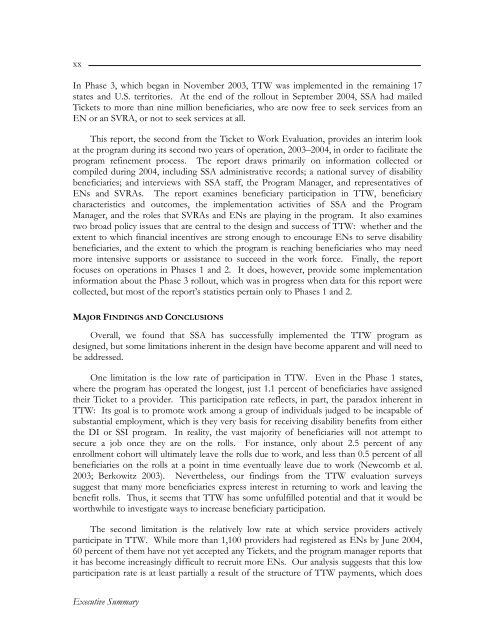Evaluation of the Ticket to Work Program, Implementation ...
Evaluation of the Ticket to Work Program, Implementation ...
Evaluation of the Ticket to Work Program, Implementation ...
You also want an ePaper? Increase the reach of your titles
YUMPU automatically turns print PDFs into web optimized ePapers that Google loves.
xxIn Phase 3, which began in November 2003, TTW was implemented in <strong>the</strong> remaining 17states and U.S. terri<strong>to</strong>ries. At <strong>the</strong> end <strong>of</strong> <strong>the</strong> rollout in September 2004, SSA had mailed<strong>Ticket</strong>s <strong>to</strong> more than nine million beneficiaries, who are now free <strong>to</strong> seek services from anEN or an SVRA, or not <strong>to</strong> seek services at all.This report, <strong>the</strong> second from <strong>the</strong> <strong>Ticket</strong> <strong>to</strong> <strong>Work</strong> <strong>Evaluation</strong>, provides an interim lookat <strong>the</strong> program during its second two years <strong>of</strong> operation, 2003–2004, in order <strong>to</strong> facilitate <strong>the</strong>program refinement process. The report draws primarily on information collected orcompiled during 2004, including SSA administrative records; a national survey <strong>of</strong> disabilitybeneficiaries; and interviews with SSA staff, <strong>the</strong> <strong>Program</strong> Manager, and representatives <strong>of</strong>ENs and SVRAs. The report examines beneficiary participation in TTW, beneficiarycharacteristics and outcomes, <strong>the</strong> implementation activities <strong>of</strong> SSA and <strong>the</strong> <strong>Program</strong>Manager, and <strong>the</strong> roles that SVRAs and ENs are playing in <strong>the</strong> program. It also examinestwo broad policy issues that are central <strong>to</strong> <strong>the</strong> design and success <strong>of</strong> TTW: whe<strong>the</strong>r and <strong>the</strong>extent <strong>to</strong> which financial incentives are strong enough <strong>to</strong> encourage ENs <strong>to</strong> serve disabilitybeneficiaries, and <strong>the</strong> extent <strong>to</strong> which <strong>the</strong> program is reaching beneficiaries who may needmore intensive supports or assistance <strong>to</strong> succeed in <strong>the</strong> work force. Finally, <strong>the</strong> reportfocuses on operations in Phases 1 and 2. It does, however, provide some implementationinformation about <strong>the</strong> Phase 3 rollout, which was in progress when data for this report werecollected, but most <strong>of</strong> <strong>the</strong> report’s statistics pertain only <strong>to</strong> Phases 1 and 2.MAJOR FINDINGS AND CONCLUSIONSOverall, we found that SSA has successfully implemented <strong>the</strong> TTW program asdesigned, but some limitations inherent in <strong>the</strong> design have become apparent and will need <strong>to</strong>be addressed.One limitation is <strong>the</strong> low rate <strong>of</strong> participation in TTW. Even in <strong>the</strong> Phase 1 states,where <strong>the</strong> program has operated <strong>the</strong> longest, just 1.1 percent <strong>of</strong> beneficiaries have assigned<strong>the</strong>ir <strong>Ticket</strong> <strong>to</strong> a provider. This participation rate reflects, in part, <strong>the</strong> paradox inherent inTTW: Its goal is <strong>to</strong> promote work among a group <strong>of</strong> individuals judged <strong>to</strong> be incapable <strong>of</strong>substantial employment, which is <strong>the</strong>y very basis for receiving disability benefits from ei<strong>the</strong>r<strong>the</strong> DI or SSI program. In reality, <strong>the</strong> vast majority <strong>of</strong> beneficiaries will not attempt <strong>to</strong>secure a job once <strong>the</strong>y are on <strong>the</strong> rolls. For instance, only about 2.5 percent <strong>of</strong> anyenrollment cohort will ultimately leave <strong>the</strong> rolls due <strong>to</strong> work, and less than 0.5 percent <strong>of</strong> allbeneficiaries on <strong>the</strong> rolls at a point in time eventually leave due <strong>to</strong> work (Newcomb et al.2003; Berkowitz 2003). Never<strong>the</strong>less, our findings from <strong>the</strong> TTW evaluation surveyssuggest that many more beneficiaries express interest in returning <strong>to</strong> work and leaving <strong>the</strong>benefit rolls. Thus, it seems that TTW has some unfulfilled potential and that it would beworthwhile <strong>to</strong> investigate ways <strong>to</strong> increase beneficiary participation.The second limitation is <strong>the</strong> relatively low rate at which service providers activelyparticipate in TTW. While more than 1,100 providers had registered as ENs by June 2004,60 percent <strong>of</strong> <strong>the</strong>m have not yet accepted any <strong>Ticket</strong>s, and <strong>the</strong> program manager reports thatit has become increasingly difficult <strong>to</strong> recruit more ENs. Our analysis suggests that this lowparticipation rate is at least partially a result <strong>of</strong> <strong>the</strong> structure <strong>of</strong> TTW payments, which doesExecutive Summary
















